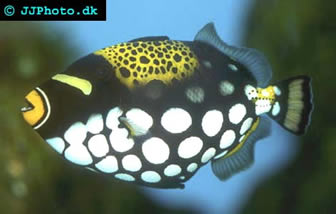Triggerfish
The triggers belong to the family Balistidae and their maximal size varies from 30 to 70 cm (12-77 inches). As you can see, they will need a big aquarium as they grow older. Triggers are found in warm waters in the Atlantic, Mediterranean Sea and Indo-Pacific Ocean. They will typically stay near the coast.
The name of the trigger fish is derived from how this fish defends itself. A trigger fish can raise the first two fin rays of its dorsal fin; the first ray will “lock” and the second one will “unlock”. As long as the fish is relaxed, the dorsal fin will be relaxed as well. If the fish feels threatened in any way, it will quickly disappear into a crack or crevice and raise its dorsal fin. The raised dorsal fin makes it very difficult for a predator to extract the trigger fish from its hiding place. A raise dorsal fin can also be helpful in cases where the fish doesn’t manage to find a crevice fast enough, since the raised fin makes the trigger fish unpleasant to swallow for predators.
One of the reasons why triggers are so popular among aquarists is their beauty. Triggers are colourful and flamboyantly decorated with lines and dots. The head is big with two small eyes capable of rotating separately from each other. The trigger fish is not a very fast or agile swimmer and prefers to use only its anal and dorsal fins to slowly glide through the water. It can however use its tail fin to gain speed if it has to.
If you want to keep triggers, it is important to provide them with many suitable hiding spots for them. As explained above, triggers need caves, cracks and crevices to retreat into. The aquarium should also have large areas open for swimming. Most species of trigger fish will need at least a 1000 L (265 gallon) aquarium to do well in captivity.
Many species can become aggressive towards other members of its own species, especially if the aquarium is too small. It is however possible to keep members of the same species together if the aquarium is large enough and cleverly decorated. Use aquarium decoration to make it possible for each fish to claim its own territory and stay away form the others. Triggers are also known to exhibit aggressive tendencies towards fish from other species.
Triggers are egg-layers and will dig a nest in the substrate before depositing their eggs. Some species guard their offspring, others do not. Certain trigger species, such as Rhinecanthus aculeatus and Balistoides viridescens, will become really aggressive during the breeding period. They will dig out round nests in the substrate and defend them violently against all intruders. In the wild, they have even chased away scuba divers.
A majority of the trigger species feed on crustaceans in the wild, but some eat zooplankton or algae. Triggers are equipped with sharp teeth and really strong jaws; otherwise they wouldn’t be able to efficiently crush hard-shelled crustaceans. You will find eight regular teeth in the lower jaw and eight regular teeth + six flat teeth in the upper jaw. When trigger fish are kept in aquariums they may gnaw on live rock and destroy corals. They can also use their strong jaws to wreck electrical wiring in the aquarium or attack aquarium equipment.
Triggers are considered difficult to keep and are only recommended for experienced saltwater aquarists with large aquariums. One of the trickiest parts is to get your triggers to eat enough in captivity. As long as the triggers eat enough, they are actually quite sturdy. Not eating enough will rapidly weaken them and make them susceptible to illness. In the wild, most triggers feed on combination of corals, sea urchins, molluscs with hard shells, and other types of invertebrates. In the aquarium they can develop a taste for other types of food as well and are for instance known to appreciate shrimps, earthworms and chopped octopus and squid. It is very important to provide your triggers with a varied diet in the aquarium.
Triggerfish Articles:
Arabian Picasso Triggerfish – Rhinecanthus assasi
Clown Trigger – Balistoides conspicillum
Niger Triggerfish – Odonus niger
Picasso Triggerfish – Rhinecanthus aculeatus
Anthias
Aquarium Chillers
Basses
Batfish
Blennies
Butterflyfish
Cardinalfish
Clown fish
Corals
Damselfish
Files
Goatfish
Gobies
Gorgonians
Grammas
Groupers
Grunts
Hawkfish
Jawfish
Jellyfish
Lionfish
Dragonets
Mantis shrimp
Marine angelfish
Marine Catfish
Moray eels
Nudibranch
Octopus
Pipefish
Protein skimmers
Pufferfish
Rabbitfish
Rays
Snappers
Scorpionfish
Sea Anemones
Sea horses
Sea Stars
Shark Fish
Shrimps
Snails
Squirellfish
Surgeonfish
Triggerfish
Wrasses

